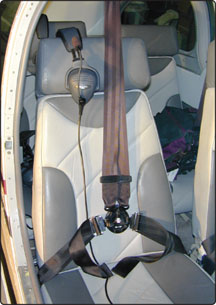
Harnessed
Two recent fatal accidents brought home for me a couple of concepts that, while not revolutionary, seem to have fallen by the wayside among many of us.
Both accidents involved Beech Bonanzas being operated by experienced pilots. Although one involved a ditching, it appears both should have been survivable. One apparently could have been avoided; the other resulted from a catastrophic engine failure, leaving the pilot with few options.
In at least one of these two accidents, the pilot and right-seater sustained what appears to have been ultimately fatal head injuries. A rear-seat passenger in this accident was able to walk away from the scene.
The first concept brought home is that accidents can and will happen to anyone, no matter how much experience the pilot may have or how inconvenient might be the timing of an in-flight emergency. We always have to be on our game, ready to implement whatever emergency procedures are called for under the circumstances.
The other concept is that the vast majority of general aviation aircraft are not the least bit crashworthy, especially when compared to automobiles. Most of the aircraft we fly left their respective factories well before similar-vintage cars and light trucks were required to have shoulder harnesses, for example. Forget about padded instrument panels, high-G seat mounts and breakaway or collapsible control yokes. Only recently have airbags made it to the general aviation market; their popularity has yet to be determined, along with their usefulness.
Even though these and other occupant-safety features have been present in automobiles-which usually travel at far lower speeds than our aircraft-for some time, its easy to find high-performance piston singles and twins with just a single lap belt to keep the pilot and front-seat passenger from getting up close and personal with the instrument panel. And if recent evidence is any guide, a single lap belt will not keep front-seaters from incurring grievous head injuries.
One solution is very simple: shoulder harnesses. When I bought my airplane, it only had a pair of lap belts at each seat. After researching the issue, I opted to install a factory kit featuring two over-the-shoulder belts on an inertial reel for each seat. It wasnt cheap, but Im confident that it was the best solution.
Since then, an enlightened FAA-surprisingly-has adopted a formal lenient policy on installing shoulder harnesses. Depending on the aircraft and the attachments methods, many installations can be accomplished with just a logbook entry; others are approved with a Form 337. Only a few require a full-blown supplemental type certificate. This is a good thing.
Im happy with my harnesses and confident they will keep me out of the panel if the airplane comes to a sudden stop. No, I havent had the opportunity to conduct a full-scale test of my belts. But others have.
-Jeb Burnside




